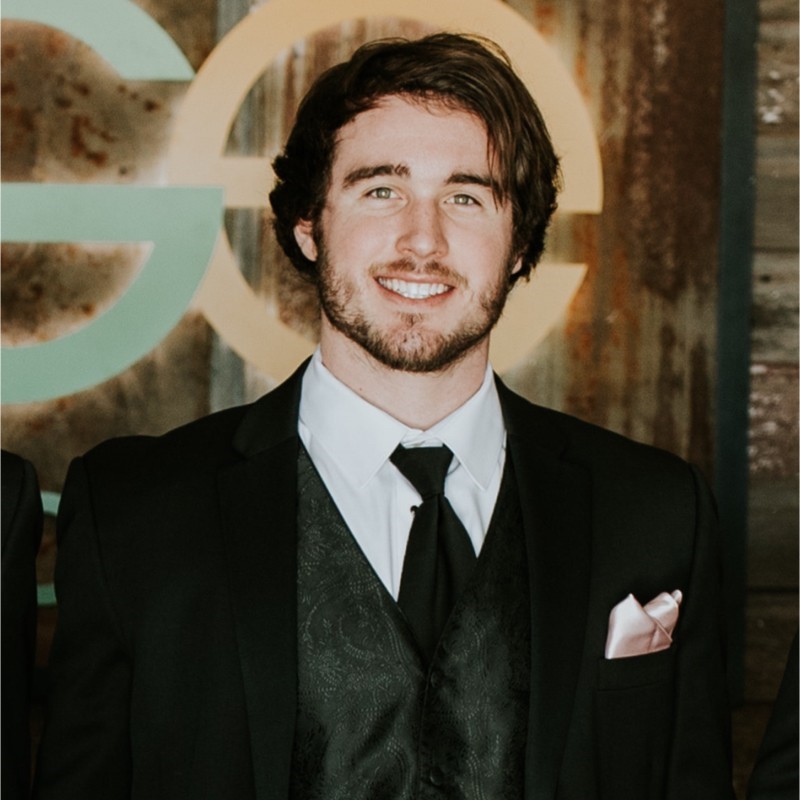By Connie Kachel White
Wichita State has long been lauded for its aviation research. Today, WSU ranks No. 1 in aerospace R&D expenditures, and its full research wingspan covers every academic discipline on campus.
Archie J. Lear would be amazed.
If the 1924 Fairmount College business administration graduate and U.S. patent holder (No. 1350228, awarded 1920, expired 1937) hailing from rural Norwich, Kansas, were somehow dropped in the middle of campus today, he’d recognize the men’s dormitory, now Fiske Hall, but little else. Not the stately National Institute for Aviation Research (NIAR) building along Campus Drive. Certainly not the university’s extensive network of research centers, labs and testing spaces.
What would Lear think of the Shocker Fly Lab that’s being planned now for the university’s Innovation Campus? Or of NIAR’s off-campus MRO hangar in south Wichita where Shawn Ehrstein ’92/96/00, NIAR director for emerging technologies and CAD/CAM, leads a cadre of students and staff working on completing the most significant industry contract in Wichita State’s history?
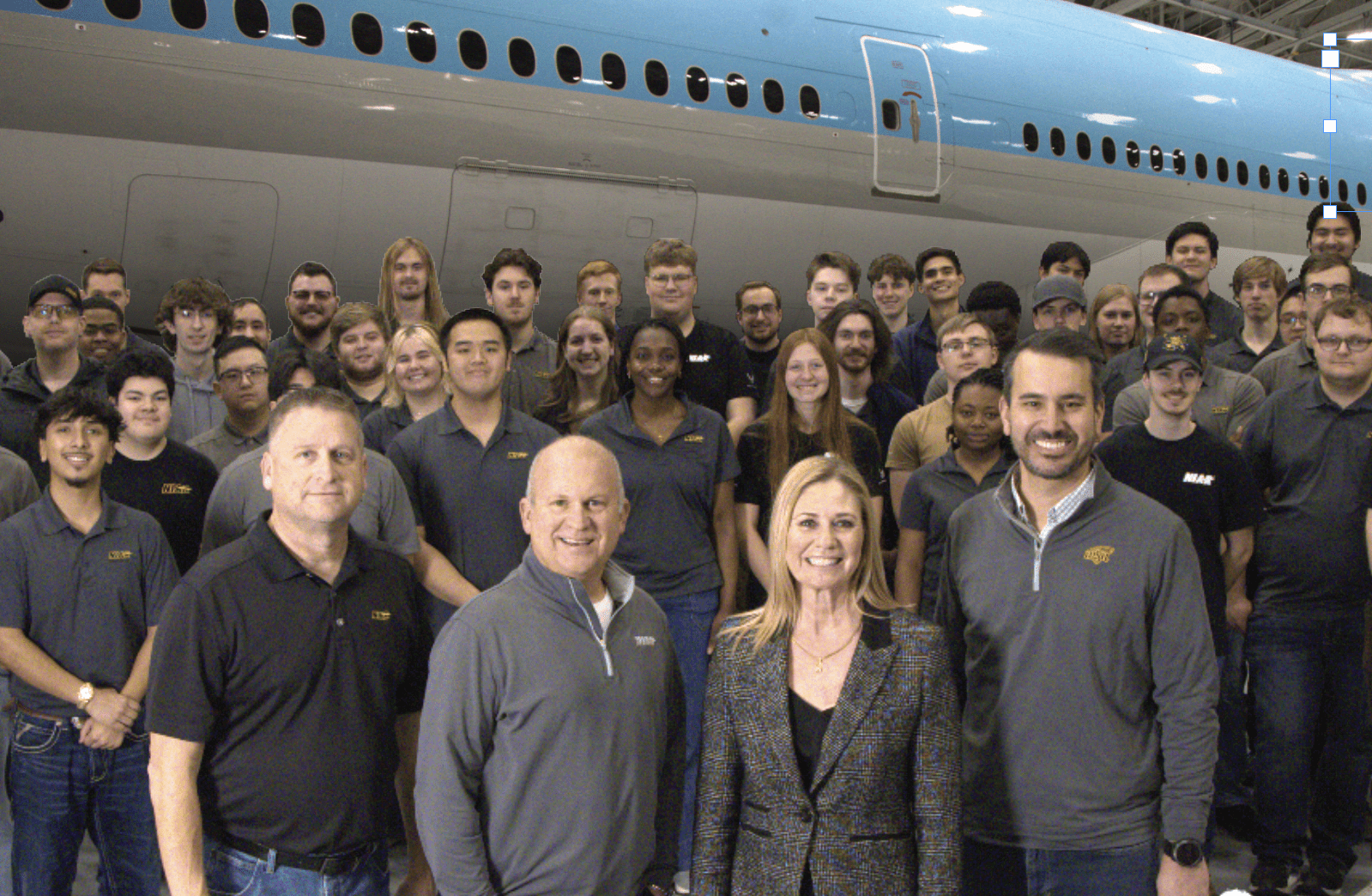
During a worksite tour in January, Ehrstein – along with John Tomblin, NIAR’s executive director who also serves as WSU executive vice president for research and industry and defense programs; Monica Lounsbery, WSU senior executive vice president and provost; and Pierre Harter ’98/00, WSU associate vice president for research and industry engagement – doesn’t need to point out the hangar’s star occupant, a Boeing 747-8i long-range airliner being used to modernize the nation’s Nightwatch aircraft, the airborne command center that ensures the U.S. president, secretary of defense, and joint chiefs of staff can maintain critical command, control and communication during any national emergency, including a nuclear one. A part of the U.S. Air Force’s Survivable Airborne Operations Center (SAOC) contract, the massively complex project is a partnership between the global aerospace and national security company SNC and Wichita State.
Ehrstein, who holds both bachelor’s and master’s degrees in electrical engineering, as well as an MBA, from WSU, explains that SNC tapped WSU for the SAOC work because of NIAR’s proven expertise in composites and advanced materials, digital twin, advanced manufacturing technologies, and certification. He adds that in addition to expert staff, hundreds of WSU students are working on the project at the NIAR MRO hangar, as well as at various other labs and facilities, including WSU’s Partnership 2 (P2) building on its Innovation Campus.
Nothing Like It
“When I was a student intern, I worked at P2,” says Keenan Lee ’24, a computer science graduate and one of the NIAR research associates assigned to the Nightwatch project. “Now, I work at WERX MRO. What I’m doing here is contributing to the digital engineering efforts for the project. When I first transferred to Wichita State, I’d heard about the great opportunities available as a student intern from a close friend who works in the ATLAS lab.”
Equipped with such things as Mikrosam Dual Robot System for Tool-less Manufacturing, Pulse Thermography and High-Performance Computing, NIAR’s Advanced Technologies Lab for Aerospace Systems is a multi-disciplinary manufacturing research/testing/training/evaluation facility and engineering education program that introduces engineers, educators and others to the factories and workplaces of the future.
ATLAS is just one of NIAR’s 22 labs, located both on campus and off, that cover everything from advanced materials and crash dynamics to digital twin and extended reality.
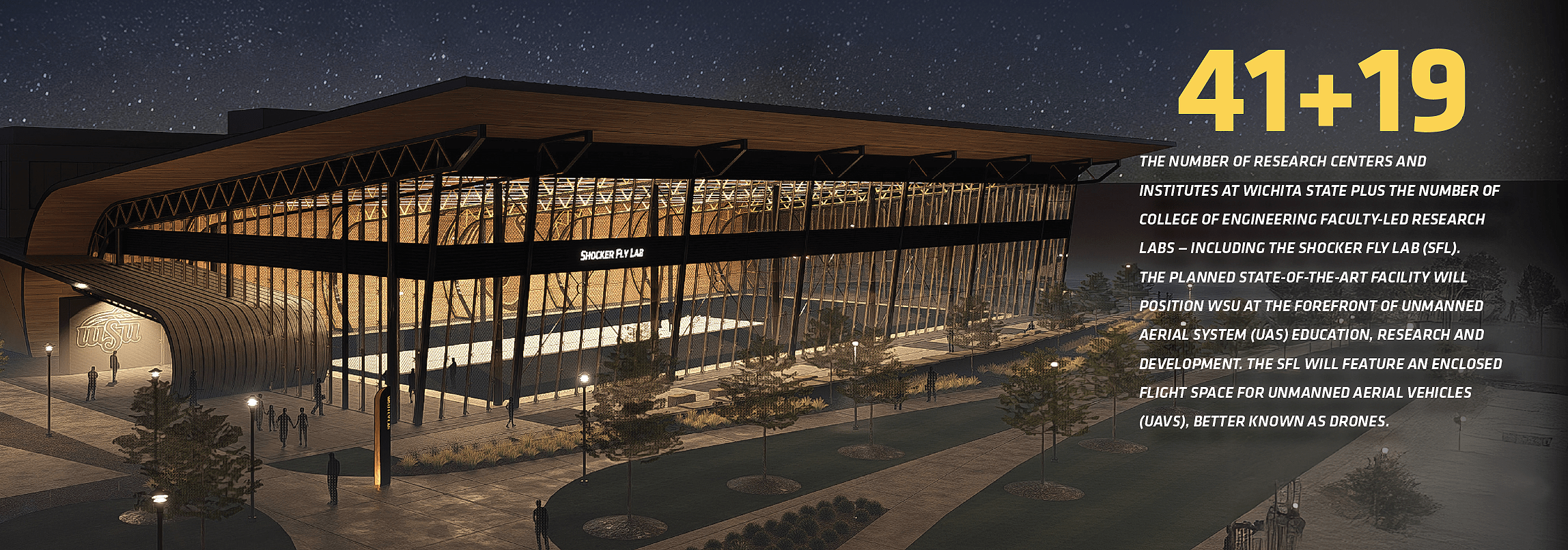
“As a NIAR intern,” Lee continues, “I initially 3D modeled aircraft parts from drawing diagrams and then transitioned to creating functional physics-based models of the aircraft’s systems. The Digital Twin Lab in P2 was extremely accommodating to work with my class schedule and other needs so I could focus on my studies first and foremost. NIAR gave me a great chance to learn what a real work environment is like and taught me important qualities, like communication, collaboration and self-responsibility.”
Among the 800 paid student interns on the job today at NIAR facilities are Elijah Wark, Khloe Donohue, Avery Morand, Cameron Morand, Boluwatito Adesina, Cecilia Vo, Amanda Tuck, Brandon Tran, Ashdon Kice, Olivia Letter, William Letter, Tori Quattlebaum, Tate Tyler, Zachary Weimorts, Joel Tweet, Konnor Brown, Connor Gartrell, Dylan Paflas, Evan Leiker, Jacob Biggs, Melody Ukoefreso, Aidan Tomblin, Dylan Dawson, Jack Jordan, Elizabeth Hayes, Aaron Hill, Cesar Lopez, Christopher Barnes, David Bayas, Nolan Donohue, Armando Duenas, Clay Wesbrooks, Colby Kelley, Dane Moorhead, Damiel Wanyonyi, Dorcas Nsimire, Dylan Dobbs, Elijah Hailey, Franque Isaac, Gabriel Yuhasz, Hoa Nguyen, Hunter Robertson, Jaron Higgins, Jenna Kasprick, Joel Banzhaf, Kobe Simmons, Levi Pompa, Maddox Kafka, Mason Clum, Michael Museousky, Minh Tran, Nathan Haynes, Patrick Mack, Patrick Rowden, Sam Reader, Samuel Schmidt, Stephan Moore II, Tanner Minette, Taylor Downs, Tyler Bixenman and Vincent Nguyen.
A century ago, there was nothing remotely like the Partnership 2 building with its seven current tenants, including the Digital Twin Lab, Machine Learning Lab, Spirit AeroSystems and Textron Aviation. There was nothing like NIAR’s off-campus MRO facility for its
Modification Repair and Overhaul (MRO), environmental test and flight test/certification services – not when Lear was on campus taking business courses and serving as captain of Fairmount’s ROTC Company B, editing features for the student newspaper and generally just enjoying college life.
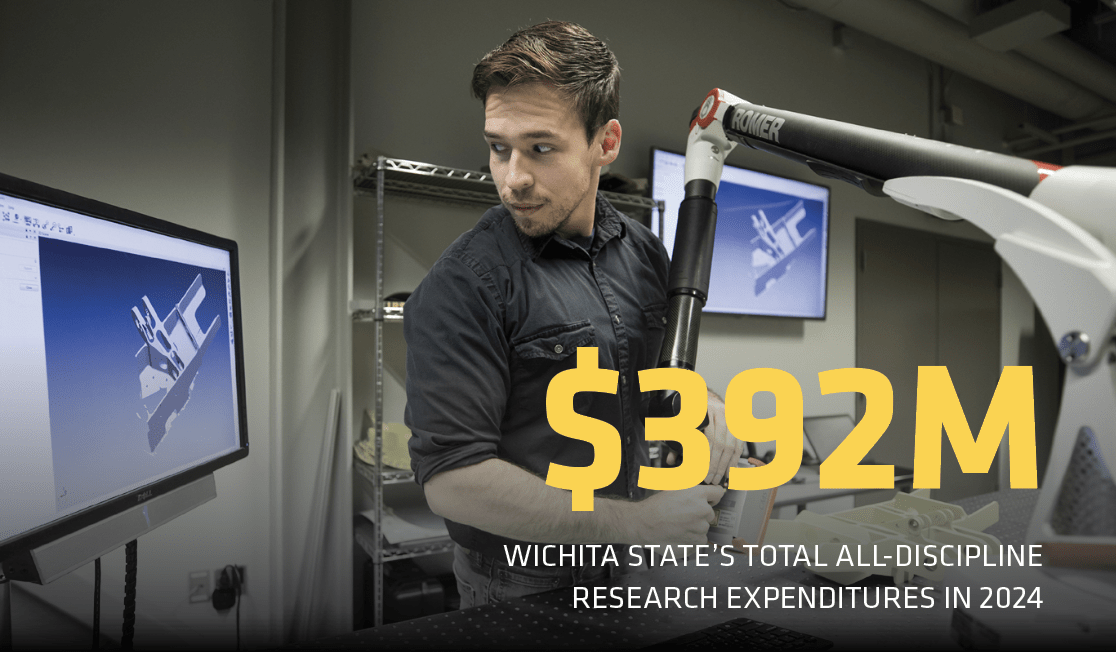
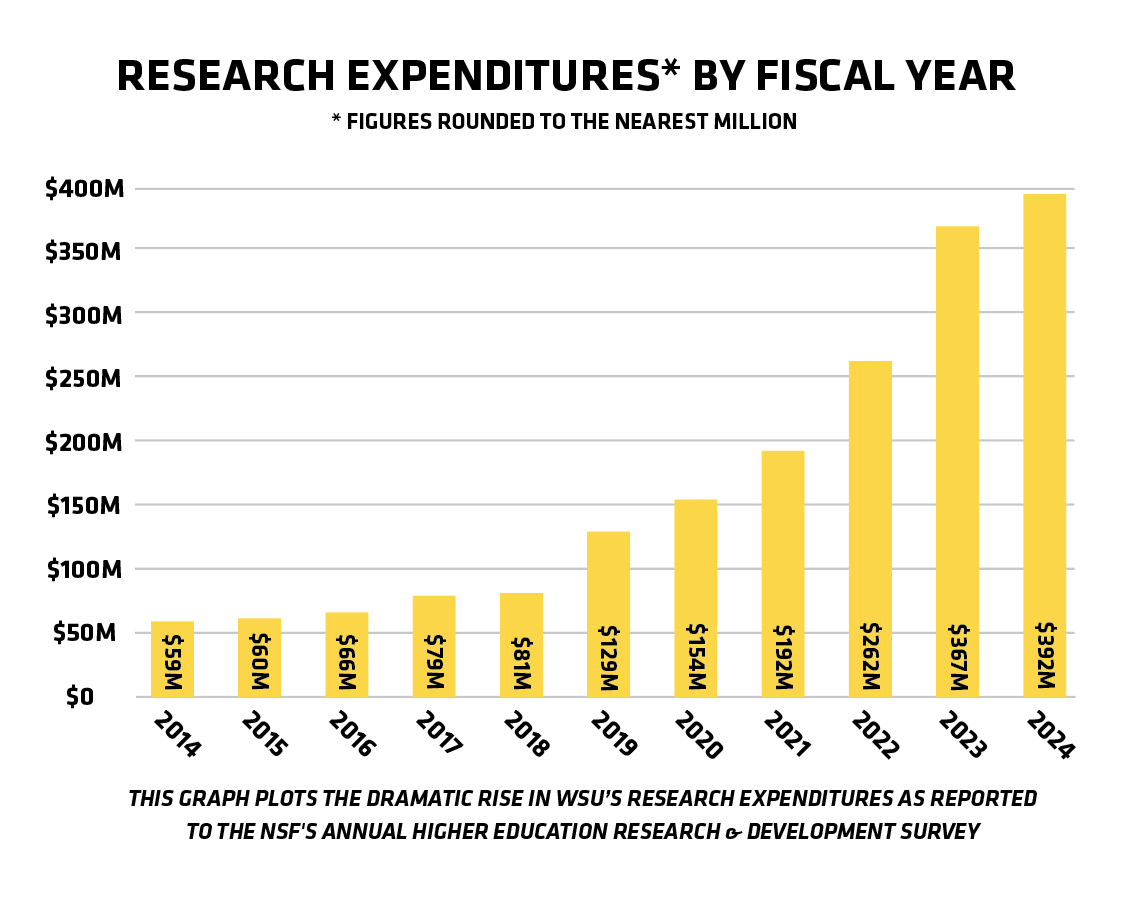
But there were glimpses.
After graduating in 1924, Lear partnered with his brother Claude on building an airplane, an undertaking that was all the rage in the Roaring ’20s – one of the high-demand occupations of its day. Then, as now, Wichita’s aircraft industry needed trained professionals, and Lear’s alma mater (as of 1926 the University of Wichita) stepped up to help meet that need. The new municipal university boasted four colleges, one of which was the College of Commerce and Industry, which included engineering courses. In those early years, the president of the university, Harold Foght, directly contacted local engineers and talked them into teaching courses in their areas of expertise. He also talked the factories and plants they worked for into contributing equipment. Classes were held downtown, in factories and machine shops.
In 1928, WU began offering a four-year bachelor’s degree in aeronautical engineering, one of only six such programs nationwide at the time. Alexander Petroff was the program’s first director, and one of his first major tasks was the construction of an on-campus wind tunnel. He designed a 4-ft, open-return tunnel made of wood that was installed in the unfinished attic of the Science Building – later renamed McKinley Hall – after its completion in 1929.
Among the few students enrolled in the program at the time was Dwane Wallace ’33, who used the wind tunnel to design and test an airplane as his senior project. That plane became the first in a series of single-engine aircraft subsequently named the Cessna Airmaster and credited with playing an important role in the revitalization of Cessna after the Great Depression.
By 1929, the year Wichita became the top producer of aircraft in the United States, the Lear brothers (no relation to Bill Lear, who founded Learjet in 1962), had set up their Lear Aircraft Co. at 263 N. Broadway in Wichita, before moving their headquarters to Pratt, Kansas. The company, with Arch as president and Claude as chief engineer and designer, built low-wing, single- and two-place planes and a two-place biplane.
Across the Board
Nearly a century later, when Lounsbery moved to Wichita this January from California where she was dean of the College of Health and Human Services at Cal State, Long Beach, to take up her post as WSU’s senior executive vice president and provost, the campus landscape was almost totally transformed from the days of Wallace and Lear.
“What’s astounding to me,” she says, “are the research facilities and equipment we have here. It’s pretty doggone apparent this university is one of the world’s leaders in aviation research. That’s our bread and butter, and I don’t know of another institution anywhere that’s better positioned to do this research than we are.” Yet her excitement about joining WSU’s top administrative team is based on something broader, more diffuse and foundational than any one area of R&D activity alone. What really excites her is Wichita State’s spirit of innovation and invention – and how that spirit of progress permeates every college, every research and service center, every academic program.

Currently, WSU is ranked by the Carnegie Foundation as a Research 2 (R2) institution. Universities in this category spend at least $5 million annually on research and award at least 20 research doctorates per year. Institutions that spend at least $50 million annually on research and award at least 70 research doctorates a year are classified Research 1 (R1), a status that accrues prestige which, in turn, can attract students, faculty, research partners and more funding opportunities – a feedback loop that, as Harter describes it, “builds on itself.”
Wichita State’s longstanding pursuit of growth opportunities in its funded research and related applied-learning portfolio resulted, years ago, in blowing well past the $50 million threshold in R&D expenditures for an R1 designation. In fact, every single year since 2014, WSU has exceeded its own record-setting expenditure total and is today reaching for the $400 million mark. Harter, who earned both bachelor’s and master’s degrees in aerospace engineering at WSU, has seen his alma mater’s growth in research activity first-hand. As an undergrad in 1994, he landed a job at what eventually became the National Center for Advanced Materials Performance (NCAMP). “Back then,” he says, “we were about a dozen students working with a couple of staff members in the composites lab, and you look at today and, wow, we’re over 200 students and staff in that lab alone.”
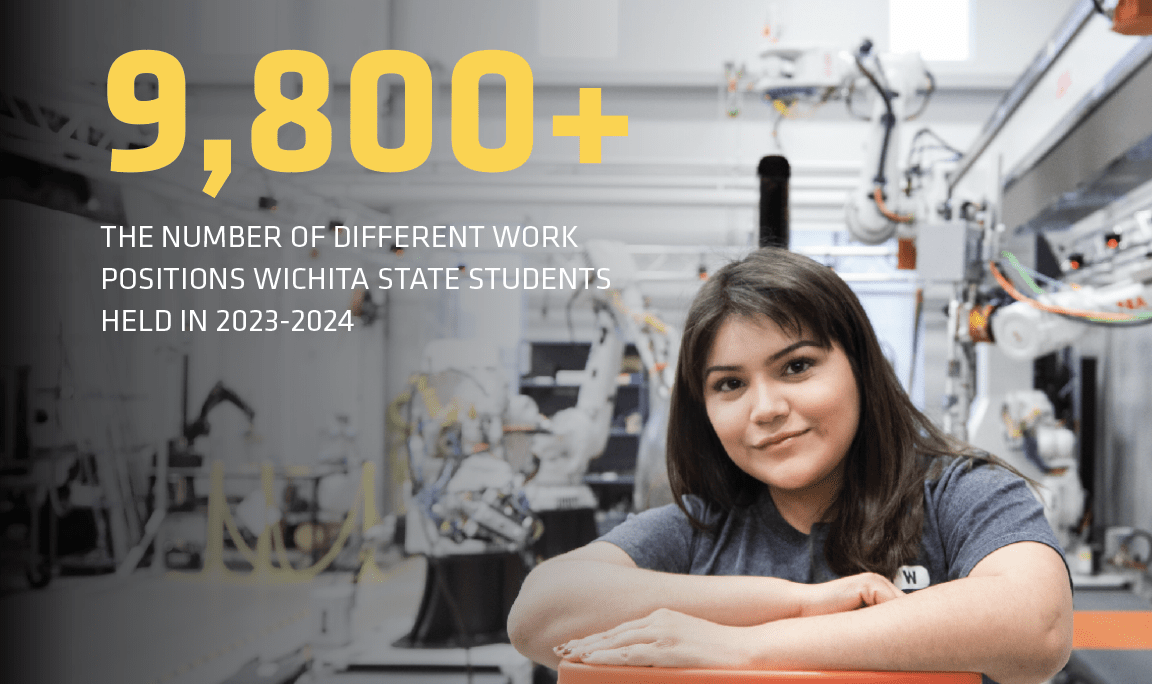
Harter went on to parlay the practical know-how he picked up as a student in the composites lab and the theoretical knowledge he gained in the classroom into successful stints in executive leadership roles at Spirit AeroSystems, Bombardier Learjet and Adam Aircraft Industries before returning to WSU in 2020. Appointed associate vice president for research in 2024, he now focuses on increasing faculty-led academic research, especially interdisciplinary research, with the goal of continuing WSU’s expansion of applied research and learning across the board.
He’s also working with other top university administrators, faculty and staff to grow enrollment in undergraduate and graduate programs – and to help get WSU across the Carnegie Foundation’s second threshold for R1 status: awarding 70 research doctorates per year.
“Right now,” says Coleen Pugh, graduate school dean and professor of chemistry who prior to coming to WSU was a professor of polymer science at the University of Akron (Ohio), “we’re awarding around 45 doctoral degrees that are considered research doctorates and so count toward an R1 designation.”
She adds that it’s interesting to see the data on the number of graduates in top performing graduate programs overall totaled over the past three years. When it comes to master’s degree programs, she says, “the College of Engineering’s computer science program has the highest number with 798 graduates. Coming in second is the Barton School of Business with 235 MBA graduates, and the school’s new business analytics degree is coming on strong with 80 grads.”
Regarding doctorates, Pugh reports these as the number of grads in the past three years by program: physical therapy, 121; nursing practice, 55; school psychology, 39; psychology (with three PhDs), 26; audiology, 20; electrical engineering and computer science, 17; industrial engineering, 17; mechanical engineering, 12; chemistry, nine; applied mathematics and physics, eight; aerospace engineering, six; and communication sciences and disorders, three.
While the university works to grow its graduate programs and continues to up its research activity in areas within its core competencies, increasing attention is being paid to encouraging and expanding faculty-led research in less traditionally funded areas and developing new research programs, like the PhD in Education and Behavioral Analysis now being considered by the Kansas Board of Regents.
“Academic research can generate innovative ideas in any field, and thereby brings unique perspectives to applied research,” Pugh says, going on to cite as an example Darren DeFrain, professor of English and director of WSU’s writing program, who was recently awarded $150,000 by the National Endowment for the Humanities to further develop a smartphone application that lets visually impaired people read materials rich in visual content. Called Vizling, the app merges the visual and text components of graphic novels, comic books and other image-heavy literature.
Nothing but Sky
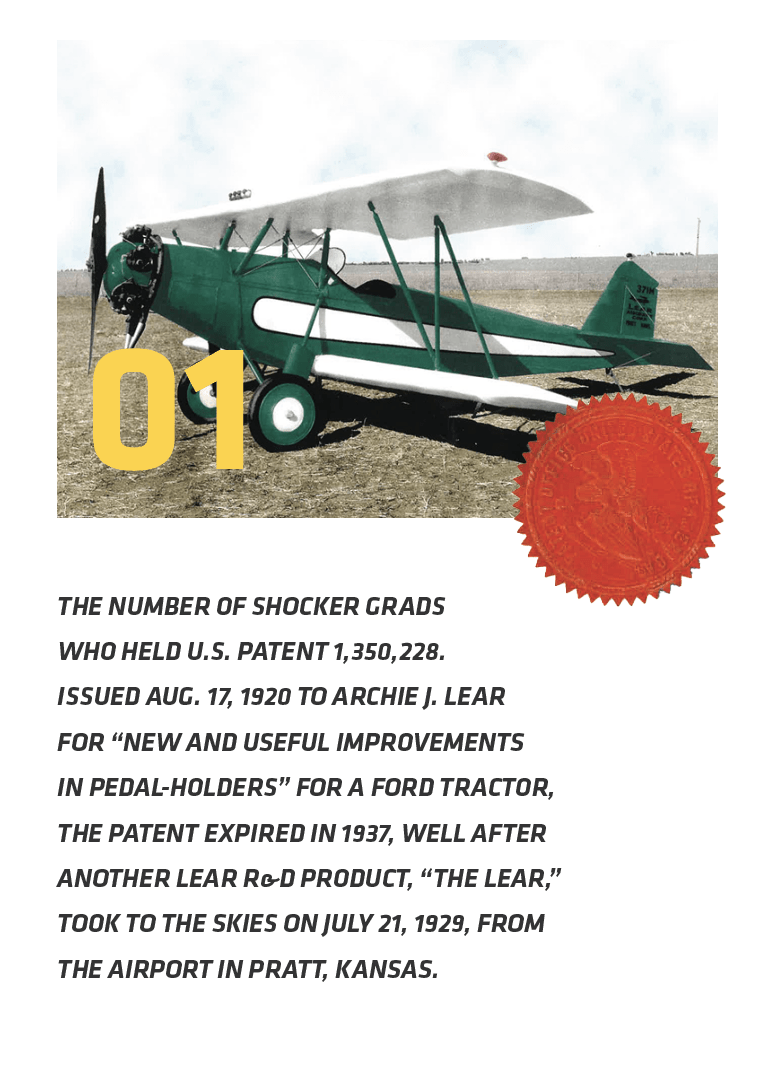
Cross-discipline collaborations on basic and applied research is poised to take off in all academic directions. With construction underway on multiple major projects on campus and off – including the Wichita Biomedical Campus, a joint WSU, WSU Tech and University of Kansas $300 million health sciences facility going up in the heart of downtown – the environment has never been better for innovation, invention and learning.
“Learning is doing,” Lounsbery says. “We have lots of opportunities for students to get real-world experience alongside their degree, and it’s going to become increasingly important for students in every academic area to obtain skills that will set them apart in the very competitive nature of the jobs market today. We want our graduates to be the top candidate in any field.”
Way back in 1929, a Kansas newspaper recorded this about a Lear Aircraft product design: “The plane offers something entirely new in aircraft engineering. One point specially stressed by the Lear boys was the slotted wings with new air foil. The plane has a Velie 5-cylinder Radio motor weighing 235 pounds. It has a 24 foot, 1 inch wing spread and a 5 foot chord or wing width.”
Much has changed since then. But not everything.
As Lounsbery says: “The sky’s the limit of what can happen here at this university.”
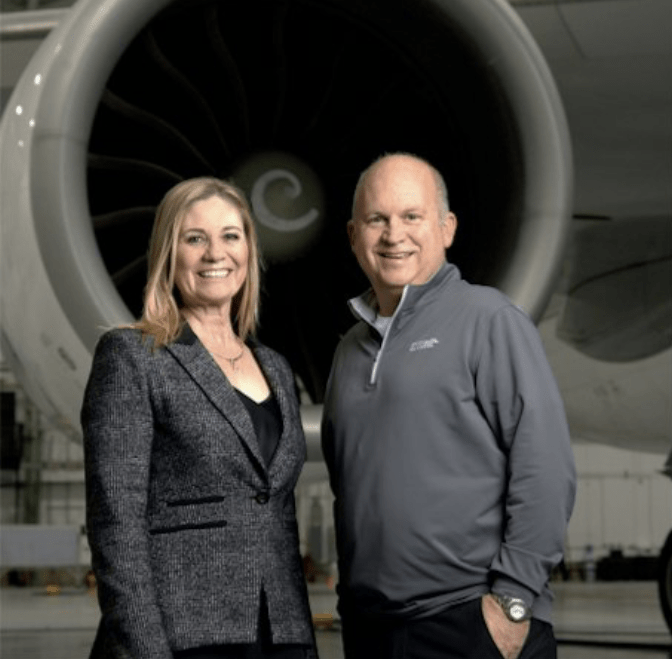
“Since coming to Wichita State University as our senior executive vice president and provost in January, Monica Lounsbery has demonstrated remarkable leadership and vision. Her enthusiastic approach and innovative spirit have already begun to foster a culture of applied learning and research excellence across all academic disciplines.”
JOHN TOMBLIN, WSU Executive Vice President for Research and Industry and Defense Programs, NIAR Executive Director

